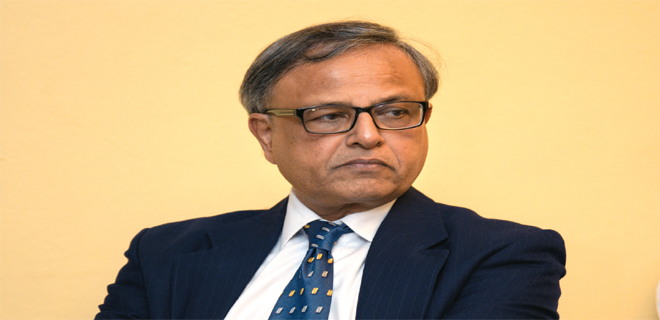Non-annuity payout options possible under NPS
Hemant G Contractor, Chairman, PFRDA on how recent changes have made NPS more attractive

Hemant G Contractor, Chairman, PFRDA speaks to Outlook Money on how recent changes have made NPS more attractive, and more. Excerpts:
Have the additional tax benefits and seamless on-boarding process through eNPS been the tipping points for the progression of NPS?
The additional tax benefits that the government gave through Section 80CCD (1B) helped, as a lot of people who were sitting on the fence actually did decide to come to the NPS. The launch of eNPS made it very convenient for the people to join if they had Aadhaar or PAN card. The on-boarding through the eNPS is now just a five-minute process. This has greatly helped the progression of NPS which is reflecting in the numbers as well: more than 35,000 NPS accounts have got opened in the last three months alone. We have seen that it normally peaks around the financial year end when many people start investing for tax purposes. I suppose the trend will continue this year as well.
But, on analysing the AUM data, the per subscriber asset broadly is still less than Rs 1 lakh.
We have now over 1.22 crore subscribers, out of which more than half, i.e. 65 lakh subscribers, are from the Swavalamban scheme and the Atal Pension Yojna (APY). There are around 38-40 lakh subscribers under Swavalamban scheme and around 27 lakh under APY, and both these schemes are low value schemes for the underprivileged with a small contribution of just Rs42 a month. Therefore, although the corpus is building up, it’s not very high and while the number of NPS subscribers has gone up rapidly over the years, the corpus would take time to build up.
What initiatives are being undertaken by PFRDA to ensure that the NPS subscribers build up an adequate corpus to be able to receive the right annuity as per their lifestyle needs?
We want to step up the financial literacy drive and explain to people the need for adequate retirement planning as clearly the saving for retirement is not the top priority for people. At present, in terms of demographics, those under 25 years of age are almost 50 per cent of the total population and retirement is the last thing on their mind. The irony is that if they don’t start young, it will be difficult to build a good corpus over time. We also have a joint literacy forum along with other financial sector regulators as well through which we have reached schools all across the country. We conduct financial literacy tests as well. This is to inculcate the habit of financial planning early on. This year more than 1 lakh students have appeared for these tests and the target is to have more than 5 lakh students. Further, we are also trying to increase the distribution base through asking banks, which are the biggest distributors of NPS, to distribute NPS through more and more number of branches.
What’s your perspective on the concept of Retirement Advisors and whether this concept would find takers in the intermediation domain?
The whole idea of having Retirement Advisors is that unlike other schemes, NPS is a defined contribution product in which the amount that a subscriber gets depends upon his or her contribution and the linked returns over a period of time and there are a whole lot of decisions that a subscriber has to take. However, the levels of awareness and financial literacy are very low in the country, therefore these set of Retirement Advisors could serve as an effective bridge as they could counsel the people in right manner. While Retirement Advisors could be individuals or firms, etc., we expect a lot of individuals to sign up as Retirement Advisors.
Do you see a case for enhancement for permissible equity allocation under NPS and also inclusion of other asset classes like alternative assets in the coming times?
Presently we have one default scheme under which equity is capped at 50 per cent, but now we have proposed two more lifecycle schemes: one is an aggressive scheme under which equity allocation can go as high as 75 per cent and the other one is a conservative scheme where equity allocation would be capped at 25 per cent. The consultation paper is out in the public domain for feedback and once it is approved, a subscriber under lifecycle fund would be able to invest up to 75 per cent in equities. Further, we are also creating a new asset class called Alternative Investments where maximum 5 per cent can be invested. Earlier, Alternative Investments were a part of corporate bonds, however, now it has been carved out separately.
Could we expect similar increase in permissible equity allocation under active choice as well in the coming times?
Well, not as of now. We’ll see how the increased allocation in equities in the passive lifecycle fund goes.
Compared to NPS in which returns are not advertised, the Atal Pension Yojna (APY) advertises assured annuities and corpus. Do you think in future we could have similar approach towards NPS where pension fund managers or annuity providers can market long-term guaranteed returns or annuities?
We are planning to come out with a scheme called ‘minimum assured return’. Under the PFRDA Act, we are required to offer this choice to the subscribers. However, the returns would be market-linked.
The talks on allowing EPFO subscribers to switch to NPS have been on the anvil. Are you ready to handle such a move if many subscribers move to NPS?
Handling of the subscribers won’t be much of a problem; however, the modalities would have to be worked out as some statutory changes are required to be made both in the PFRDA Act as well as the EPFO Act. EPFO is a mandatory scheme unlike NPS, and this is required to be changed for it to happen. The other thing is that EPFO still remains a completely tax free scheme whereas in NPS, although tax exemption has been given only on 40 per cent of the corpus, it still remains a taxable scheme. For any person moving from EPF to NPS, this tax may be an important consideration. Further, we get this feedback that presently some people may be unhappy about the administration hassles and compliance requirements with respect to EPF which are not there in the NPS. In addition, with the recent Budget announcement, while EPF and NPS were made at par, with the recent roll back, the tax advantage is still there with EPF.
The lacuna with NPS is the payout phase where the annuity goes against subscribers owing to taxation issues. Why not think of a non annuity payout option?
We are looking at non annuity payout options under NPS. This is there in the consultation paper as well. We are looking at alternatives to annuities like systematic withdrawals over a period of time and we’ll look at the longevity tables and based on that take a call. The non annuity options are not yet approved but we are looking at it very closely as we also feel that there should be some alternative to annuities. However, while such options may provide for higher amounts, the danger is that people may run out of money if they live longer. This is not the case with annuities. So, we want to give it as an option and not as a replacement of annuities.
The Tier–2 NPS account also has tax disadvantage; will this get resolved soon?
We have written to CBDT to treat Tier-2 accounts on par with mutual funds; however, we are still to hear from them on that. We feel that Tier-2 accounts should be on the same footing as mutual funds.







